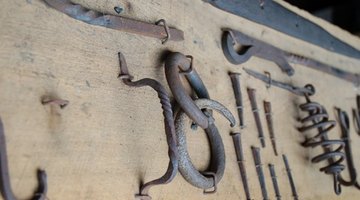How to Clean Old Tools
Antique tool dealers and collectors often come across dirty and rusty tools. When restoring old tools, it is essential to only clean them. Old tools should not be refinished, as finishing is not reversible and will cause the tools to lose value.

Since oxygen and water usually mar most metals over time, rust is the primary factor with old tools. Rust and dirt can be removed from old tools, using certain solutions and materials. Abrasives should never be applied to antique tools, but can be used on common user tools.
Things You Will Need
- High-quality museum grade wax
- 2 soft rags
- Dry automotive rubbing compound
- Old cloth
- Linseed oil
- Stainless steel brush
- Liquid dish detergent
- Water
- Clean cloth
- Dry towel
Cleaning antique tools
-
Apply a high-quality museum grade wax to a soft rag. Rub the rag over the entire tool to safely remove rust and dirt. Since wax can be removed easily, the tool will not be harmed.
-
Inspect the tool for further rust. If the tool is still extremely dirty and rusty, apply dry automotive rubbing compound sparingly to a soft rag. Use red rubbing compound, not the finer white polishing compound.
-
Rub the red compound into the tool, using the soft rag. Continue to apply rubbing compound to the tool until no more dirt and rust remain.
Cleaning common user tools
-
Dampen an old cloth in linseed oil. Wipe the dampened cloth over the tool, to thoroughly coat the metal with the oil.
-
Allow the linseed oil to soak into the metal for 10 minutes. Use a stainless steel brush to scrape off rust and dirt from the tool.
-
Apply a couple of drops of liquid dish detergent to a clean cloth. Dampen the cloth with water, to create suds.
-
Clean the tool with the soapy cloth, to rinse off the linseed oil and remove remaining dirt. Rinse the tool with water, to remove the soapy solution.
-
Wipe the tool thoroughly with a dry towel. Failure to dry the tool will cause it to rust again.
Tip
Wax can be applied to a very fine steel wool pad, as a last resort for cleaning extremely dirt or rusty antique tools.
Warning
Do not use steel wool on a rare or valuable tool. It can cause the tool to lose its value.
The Drip Cap
- Antique tool dealers and collectors often come across dirty and rusty tools.
- Old tools should not be refinished, as finishing is not reversible and will cause the tools to lose value.
- If the tool is still extremely dirty and rusty, apply dry automotive rubbing compound sparingly to a soft rag.
- Apply a couple of drops of liquid dish detergent to a clean cloth.
- Clean the tool with the soapy cloth, to rinse off the linseed oil and remove remaining dirt.
References
Writer Bio
April Dowling first started writing in high school and has written many news articles for newspaper and yearbook publications. She is currently pursuing a career as an online writer and affiliate marketer. Dowling writes for several websites and keeps many blogs.
Photo Credits
- antique hardware image by Joy Fera from Fotolia.com
- antique hardware image by Joy Fera from Fotolia.com
More Articles



